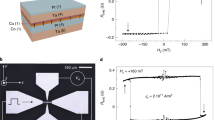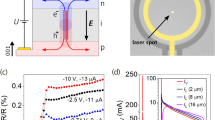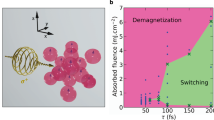Abstract
The idea to use not only the charge but also the spin of electrons in the operation of electronic devices has led to the development of spintronics, causing a revolution in how information is stored and processed. A novel advancement would be to develop ultrafast spintronics using femtosecond laser pulses. Employing terahertz (1012 Hz) emission spectroscopy and exploiting the spin–orbit interaction, we demonstrate the optical generation of electric photocurrents in metallic ferromagnetic heterostructures at the femtosecond timescale. The direction of the photocurrent is controlled by the helicity of the circularly polarized light. These results open up new opportunities for realizing spintronics in the unprecedented terahertz regime and provide new insights in all-optical control of magnetism.
This is a preview of subscription content, access via your institution
Access options
Subscribe to this journal
Receive 12 print issues and online access
$259.00 per year
only $21.58 per issue
Buy this article
- Purchase on Springer Link
- Instant access to full article PDF
Prices may be subject to local taxes which are calculated during checkout



Similar content being viewed by others
References
Ganichev, S. D. et al. Spin-galvanic effect. Nature 417, 153–156 (2002).
Bychkov, Y. A. & Rashba, É. I. Properties of a 2D electron gas with lifted spectral degeneracy. JETP Lett. 39, 78–81 (1984).
Chernyshov, A. et al. Evidence for reversible control of magnetization in a ferromagnetic material by means of spin–orbit magnetic field. Nature Phys. 5, 656–659 (2009).
Miron, I. M. et al. Perpendicular switching of a single ferromagnetic layer induced by in-plane current injection. Nature 476, 189–193 (2011).
Freimuth, F., Blügel, S. & Mokrousov, Y. Spin-orbit torques in Co/Pt(111) and Mn/W(001) magnetic bilayers from first principles. Phys. Rev. B 90, 174423 (2014).
Kurebayashi, H. et al. An antidamping spin–orbit torque originating from the Berry curvature. Nature Nanotech. 9, 211–217 (2014).
Ciccarelli, C. et al. Magnonic charge pumping via spin–orbit coupling. Nature Nanotech. 10, 50–54 (2015).
Bernevig, B. A. & Vafek, O. Piezo-magnetoelectric effects in p-doped semiconductors. Phys. Rev. B 72, 033203 (2005).
Manchon, A. & Zhang, S. Theory of spin torque due to spin–orbit coupling. Phys. Rev. B 79, 094422 (2009).
Brataas, A., Kent, A. D. & Ohno, H. Current-induced torques in magnetic materials. Nature Mater. 11, 372–381 (2012).
Garello, K. et al. Symmetry and magnitude of spin–orbit torques in ferromagnetic heterostructures. Nature Nanotech. 8, 587–593 (2013).
Pershan, P. S., van der Ziel, J. P. & Malmstrom, L. D. Theoretical discussion of the inverse Faraday effect, Raman scattering, and related phenomena. Phys. Rev. 143, 574–583 (1966).
Kimel, A. V. et al. Ultrafast non-thermal control of magnetization by instantaneous photomagnetic pulses. Nature 435, 655–657 (2005).
Němec, P. et al. Experimental observation of the optical spin transfer torque. Nature Phys. 8, 411–415 (2012).
Stanciu, C. D. et al. All-optical magnetic recording with circularly polarized light. Phys. Rev. Lett. 99, 047601 (2007).
Lambert, C. H. et al. All-optical control of ferromagnetic thin films and nanostructures. Science 345, 1337–1340 (2014).
Mangin, S. et al. Engineered materials for all-optical helicity-dependent magnetic switching. Nature Mater. 13, 286–292 (2014).
Koopmans, B., Groot Koerkamp, M., Rasing, Th. & Van den Berg, H. Observation of large Kerr angles in the nonlinear optical response from magnetic multilayers. Phys. Rev. Lett. 74, 3692–3695 (1995).
Wierenga, H. A. et al. Interface magnetism and possible quantum well oscillations in ultrathin Co/Cu films observed by magnetization induced second harmonic generation. Phys. Rev. Lett. 74, 1462–1465 (1995).
Romming, N. et al. Writing and deleting single magnetic skyrmions. Science 341, 636–639 (2013).
Dupé, B., Hoffmann, M., Paillard, C. & Heinze, S. Tailoring magnetic skyrmions in ultra-thin transition metal films. Nature Commun. 5, 4030 (2014).
Pyatakov, A. P. & Zvezdin, A. K. Dzyaloshinskii–Moriya-type interaction and Lifshitz invariant in Rashba 2D electron gas systems. EPL 107, 67002 (2014).
Weber, W. et al. Magneto-gyrotropic photogalvanic effects in GaN/AlGaN two-dimensional systems. Solid State Commun. 145, 56–60 (2008).
Malinowski, G. et al. Control of speed and efficiency of ultrafast demagnetization by direct transfer of spin angular momentum. Nature Phys. 4, 855–858 (2008).
Melnikov, A. et al. Ultrafast transport of laser-excited spin-polarized carriers in Au/Fe/MgO(001). Phys. Rev. Lett. 107, 076601 (2011).
Rudolf, D. et al. Ultrafast magnetization enhancement in metallic multilayers driven by superdiffusive spin current. Nature Commun. 3, 1037 (2012).
Kampfrath, T. et al. Terahertz spin current pulses controlled by magnetic heterostructures. Nature Nanotech. 8, 256–260 (2013).
Choi, G.-M., Min, B.-C., Lee, K.-J. & Cahill, D. G. Spin current generated by thermally driven ultrafast demagnetization. Nature Commun. 5, 4334 (2014).
Mosendz, O. et al. Quantifying spin Hall angles from spin pumping: experiments and theory. Phys. Rev. Lett. 104, 046601 (2010).
Liu, L. et al. Spin–torque switching with the giant spin Hall effect of tantalum. Science 336, 555–558 (2012).
Kim, J. et al. Layer thickness dependence of the current-induced effective field vector in Ta|CoFeB|MgO. Nature Mater. 12, 240–245 (2013).
Rojas-Sánchez, J.-C. et al. Spin pumping and inverse spin Hall effect in platinum: the essential role of spin-memory loss at metallic interfaces. Phys. Rev. Lett. 112, 106602 (2014).
Schleicher, J. M., Harrel, S. M. & Schmuttenmaer, C. A. Effect of spin-polarized electrons on terahertz emission from photoexcited GaAs. J. Appl. Phys. 105, 113116 (2009).
Choi, G.-M. Ultrafast Laser Driven Spin Generation in Metallic Ferromagnets PhD thesis, Univ. Illinois (2015).
Drezet, A., Genet, C. & Ebbesen, T. W. Miniature plasmonic wave plates. Phys. Rev. Lett. 101, 043902 (2008).
Biagioni, P. et al. Near-field polarization shaping by a near-resonant plasmonic cross antenna. Phys. Rev. B 80, 153409 (2009).
Mikhaylovskiy, R. V. et al. Ultrafast modification of exchange interactions in iron oxides. Nature Commun. 6, 8190 (2015).
Huisman, T. J., Mikhaylovskiy, R. V., Tsukamoto, A., Rasing, Th. & Kimel, A. V. Simultaneous measurements of terahertz emission and magneto-optical Kerr effect for resolving ultrafast laser-induced demagnetization dynamics. Phys. Rev. B 92, 104419 (2015).
Acknowledgements
The authors thank T. Toonen, A. van Etteger and S. Semin for technical support and A. Brataas, A. Kirilyuk, A.K. Zvezdin and V.V. Bel'kov for discussions. This work was supported by the Foundation for Fundamental Research on Matter (FOM), the European Union's Seventh Framework Programme (FP7/2007-2013) grants no. 280555 (Go-Fast) and no. 281043 (FemtoSpin), projects no. Norte-070124-FEDER-000070 and no. FEDER-POCTI/0155, European Research Council grants no. 257280 (Femtomagnetism) and no. 339813 (Exchange), and the ‘Leading Scientist’ programme of the Russian Ministry of Education and Science (14.Z50.31.0034). J.D.C. acknowledges FCT grant no. SFRH/BD/7939/2011.
Author information
Authors and Affiliations
Contributions
T.J.H., R.V.M., J.D.C. and A.V.K. conceived the experiments. T.J.H. and R.V.M. designed and built the experimental set-up. T.J.H. performed the measurements and analysed the data with help from R.V.M. and A.V.K. J.D.C. fabricated and characterized the samples with help from E.P., J.V. and P.P.F. The theoretical formalisms were derived by T.J.H., R.V.M. and F.F., with contributions from Y.M., S.B. and A.V.K. T.J.H., R.V.M., F.F. and A.V.K. co-wrote the paper. All authors discussed the results and commented on the manuscript. The project was coordinated by A.V.K.
Corresponding author
Ethics declarations
Competing interests
The authors declare no competing financial interests.
Supplementary information
Supplementary information
Supplementary information (PDF 451 kb)
Rights and permissions
About this article
Cite this article
Huisman, T., Mikhaylovskiy, R., Costa, J. et al. Femtosecond control of electric currents in metallic ferromagnetic heterostructures. Nature Nanotech 11, 455–458 (2016). https://doi.org/10.1038/nnano.2015.331
Received:
Accepted:
Published:
Issue Date:
DOI: https://doi.org/10.1038/nnano.2015.331
This article is cited by
-
Ultrafast terahertz emission from emerging symmetry-broken materials
Light: Science & Applications (2023)
-
Time-domain observation of ballistic orbital-angular-momentum currents with giant relaxation length in tungsten
Nature Nanotechnology (2023)
-
Quasi-static strain governing ultrafast spin dynamics
Communications Physics (2022)
-
Ultrafast kinetics of the antiferromagnetic-ferromagnetic phase transition in FeRh
Nature Communications (2022)
-
Excitation and detection of coherent sub-terahertz magnons in ferromagnetic and antiferromagnetic heterostructures
npj Computational Materials (2022)



